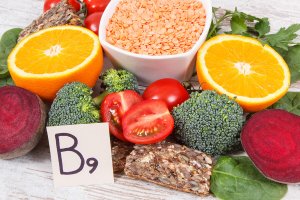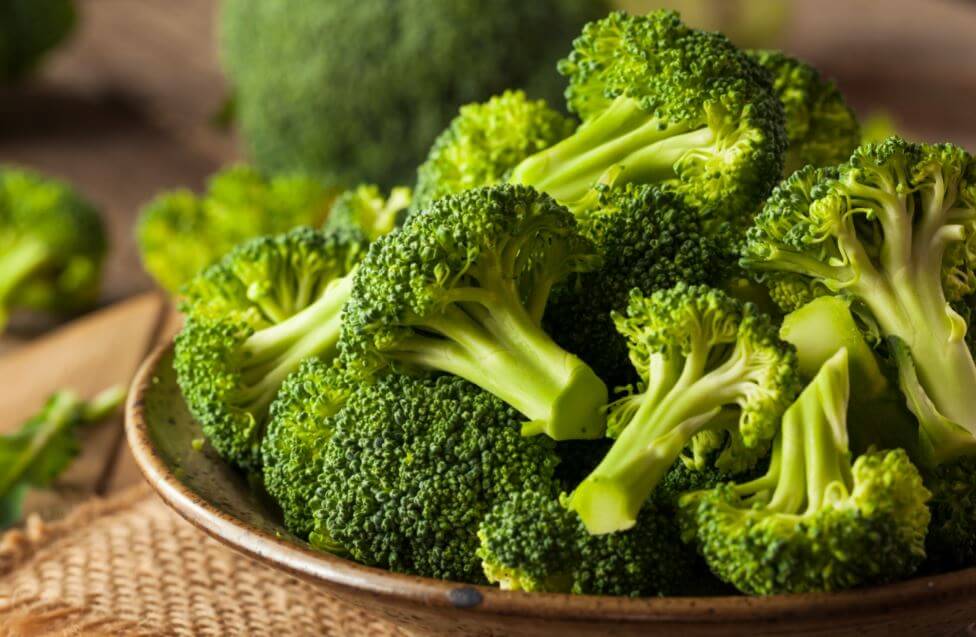Folic Acid: The Wellness Vitamin

Folic acid has received the nickname “the wellness vitamin”. It may seem a bit exaggerated, however, it isn’t. Folic acid contains a large number of properties that provide many health benefits. In this article, we’ll analyze all the health benefits and share a list of foods that contain this important vitamin.
What is folic acid?
Folic acid is a vitamin (B9). It’s a fundamental vitamin, that means it should be included in everyone’s daily diet. It plays a vital role in many biological processes that occur inside the body.
Out of all of the biological processes that folic acid plays a role in, it stands out for its important role in the proper functioning of the nervous and circulatory systems. Now, let’s analyze the main properties and benefits of folic acid.
Properties and benefits of the vitamin known as folic acid
Read along, you’ll be surprised by the health benefits this vitamin provides.
This vitamin relieves the symptoms caused by menopause
Everyone should ingest folic acid in order to enjoy good health, however, it’s especially recommended for specific groups of individuals. Folic acid is especially important for women who are suffering from the symptoms of menopause.
The symptoms of menopause vary from woman to woman, however, in general, the symptoms include hot flashes, irritability, and insomnia.
One way to deal with these symptoms or at least to reduce their intensity is to ingest foods that are rich in folic acid. This will make the process a little more bearable allowing you to carry out your daily routine without too many issues.

Folic acid is a vitamin that strengthens hair and stimulates hair growth
Some people have weak hair that grows very slowly. In addition, during fall, hair tends to shed in greater quantities, that’s why it’s important to take care of it. A natural way to do so is by ingesting foods that are rich in folic acid.
This essential vitamin helps to stimulate hair follicles, it also creates a protective layer that prevents hair from being damaged. In addition to ingesting foods that are rich in folic acid, you can also take supplements that contain this vitamin in order to contribute to hair recovery.
Fundamental for pregnant women
If you’ve been pregnant, you probably know what folic acid is. Gynecologists always place special emphasis on the importance of taking this vitamin, since it’s essential for the proper development of the future baby. Folic acid stimulates the creation of new cells and prevents problems derived from poor cell division.
If pregnant women don’t ingest enough folic acid during pregnancy, it could lead to complications for the baby such as spina bifida or cleft lip.
Foods rich in folic acid
In order to benefit from all of the health properties of folic acid, it’s important to ingest foods that are rich in the important vitamin. The following are just a few examples of foods that contain folic acid.
- Broccoli: one cup of broccoli contains 30 percent of our daily folic acid requirements. In addition, broccoli is rich in potassium, fiber, and protein. Cooking broccoli can be as simple as boiling them for 5 minutes in water with a pinch of salt. Broccoli is the perfect side dish to a plate of meat or fish.

- Asparagus: in addition to folic acid, white asparagus also contains vitamin A, B, and C. You can use asparagus to prepare a salad or a delicious cream.
- Beans: beans come in different sizes and colors, however, they all contain the same amount of folic acid. The most common way to eat beans is boiled accompanied by a light sauce. Beans are very healthy and satisfying.
- Chickpeas: contain potassium, carbohydrates, and proteins. They’re usually prepared and served with a little rice and vegetables. You can try to roast them in the oven with a few spices if you’d like to prepare a healthy snack.
- Avocados: in addition to folic acid, they also contain a large amount of healthy fats. Avocados are great on toast or in the form of guacamole. They can also be cut into cubes and added into salads.
As you can see, there are many different ways to incorporate folic acid into your diet. Take advantage of them and add this essential vitamin to your diet. Your body will thank you for it!
Folic acid has received the nickname “the wellness vitamin”. It may seem a bit exaggerated, however, it isn’t. Folic acid contains a large number of properties that provide many health benefits. In this article, we’ll analyze all the health benefits and share a list of foods that contain this important vitamin.
What is folic acid?
Folic acid is a vitamin (B9). It’s a fundamental vitamin, that means it should be included in everyone’s daily diet. It plays a vital role in many biological processes that occur inside the body.
Out of all of the biological processes that folic acid plays a role in, it stands out for its important role in the proper functioning of the nervous and circulatory systems. Now, let’s analyze the main properties and benefits of folic acid.
Properties and benefits of the vitamin known as folic acid
Read along, you’ll be surprised by the health benefits this vitamin provides.
This vitamin relieves the symptoms caused by menopause
Everyone should ingest folic acid in order to enjoy good health, however, it’s especially recommended for specific groups of individuals. Folic acid is especially important for women who are suffering from the symptoms of menopause.
The symptoms of menopause vary from woman to woman, however, in general, the symptoms include hot flashes, irritability, and insomnia.
One way to deal with these symptoms or at least to reduce their intensity is to ingest foods that are rich in folic acid. This will make the process a little more bearable allowing you to carry out your daily routine without too many issues.

Folic acid is a vitamin that strengthens hair and stimulates hair growth
Some people have weak hair that grows very slowly. In addition, during fall, hair tends to shed in greater quantities, that’s why it’s important to take care of it. A natural way to do so is by ingesting foods that are rich in folic acid.
This essential vitamin helps to stimulate hair follicles, it also creates a protective layer that prevents hair from being damaged. In addition to ingesting foods that are rich in folic acid, you can also take supplements that contain this vitamin in order to contribute to hair recovery.
Fundamental for pregnant women
If you’ve been pregnant, you probably know what folic acid is. Gynecologists always place special emphasis on the importance of taking this vitamin, since it’s essential for the proper development of the future baby. Folic acid stimulates the creation of new cells and prevents problems derived from poor cell division.
If pregnant women don’t ingest enough folic acid during pregnancy, it could lead to complications for the baby such as spina bifida or cleft lip.
Foods rich in folic acid
In order to benefit from all of the health properties of folic acid, it’s important to ingest foods that are rich in the important vitamin. The following are just a few examples of foods that contain folic acid.
- Broccoli: one cup of broccoli contains 30 percent of our daily folic acid requirements. In addition, broccoli is rich in potassium, fiber, and protein. Cooking broccoli can be as simple as boiling them for 5 minutes in water with a pinch of salt. Broccoli is the perfect side dish to a plate of meat or fish.

- Asparagus: in addition to folic acid, white asparagus also contains vitamin A, B, and C. You can use asparagus to prepare a salad or a delicious cream.
- Beans: beans come in different sizes and colors, however, they all contain the same amount of folic acid. The most common way to eat beans is boiled accompanied by a light sauce. Beans are very healthy and satisfying.
- Chickpeas: contain potassium, carbohydrates, and proteins. They’re usually prepared and served with a little rice and vegetables. You can try to roast them in the oven with a few spices if you’d like to prepare a healthy snack.
- Avocados: in addition to folic acid, they also contain a large amount of healthy fats. Avocados are great on toast or in the form of guacamole. They can also be cut into cubes and added into salads.
As you can see, there are many different ways to incorporate folic acid into your diet. Take advantage of them and add this essential vitamin to your diet. Your body will thank you for it!
All cited sources were thoroughly reviewed by our team to ensure their quality, reliability, currency, and validity. The bibliography of this article was considered reliable and of academic or scientific accuracy.
- Pita Rodríguez, G. (1998). Ácido Fólico y Vitamina B12 en la Nutricion Humana. Revista Cubana Aliment Nutr, 12(2), 107–19. https://doi.org/345-7979-867-9
- Mamani, J., Patty, A., & Henry, F. (2013). Deficiencia del acido fólico y sus repercusiones en la formación del tubo neural. SCientifica – Facultad de Medicina UMSA, (4). https://doi.org/http://dx.doi.org/10.1016/j.gie.2011.02.021
- Nieto Rodríguez, K. N., & Calvo Gómez, J. M. (2001). Ácido fólico y depresión. Revista Colombiana de Psiquiatría, 30(1), 39–49.
This text is provided for informational purposes only and does not replace consultation with a professional. If in doubt, consult your specialist.








